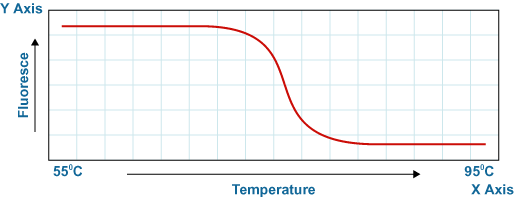References >> HRM
HRM TechnologyIntroduction to HRM
High Resolution Melting (HRM) is a homogeneous, highly powerful method for SNP genotyping, mutation scanning and sequence scanning in DNA samples. Enabled by the recent availability of improved double-stranded DNA (dsDNA)–binding dyes and next-generation real-time PCR instrumentation, High Resolution Melting Analysis is based on PCR melting (dissociation) curve techniques.
The HRM technology characterizes nucleic acid samples based on their disassociation behavior and detects small sequence differences in PCR amplified sequences, just by direct melting. Samples are also discriminated according to their sequence length, GC content and strand complementarity. With the use of specific DNA dyes, high-end instrumentation and sophisticated analysis software, these differences are detected.
Mechanism
High Resolution Melting Analysis (HRM) is a post PCR method. The region of interest within the DNA sequence is first amplified using the polymerase chain reaction. During this process, special saturation dyes are added to the reaction, that fluoresce only in the presence of double stranded DNA. Such dyes are known as Intercalating dyes.
During PCR, the region of interest amplified is known as Amplicon. As the amplicon concentration in the reaction tube increases the fluorescence exhibited by the double stranded amplified product also increases.
After the PCR process the HRM analysis begins. In this process the amplicon DNA is heated gradually from around 50°C up to around 95°C. As the temperature increases, at a point the melting temperature of the amplicon is reached and the sample DNA denatures and the double stranded DNA melts apart. Due to this the fluorescence fades away.
This is because in the absence of double stranded DNA the intercalating dyes have nothing to bind to and they only fluoresce at a low level. This observation is plotted showing the level of fluorescence vs the temperature, generating a Melting Curve. Even a single base change in the sample DNA sequence causes differences in the HRM curve. Since different genetic sequences melt at slightly different rates, they can be viewed, compared, and detected using these curves.
Melt curves generated after High Resolution Melting analysis are normally plotted with fluorescence on the Y axis and temperature on the X axis. These are similar to real-time PCR amplification plots but with the substitution of temperature for cycle number.

Intercalating Dyes for HRM Analysis
Saturating fluorescent dyes are used to monitor the denaturation of sample DNA amplicons, in order to perform HRM Analysis. Some of the commercially available dyes are:
-
LC Green
LC Green dyes are specifically designed for High Resolution Melting analysis to detect DNA sequence variants. The addition of these dyes increases the melting temperature of DNA by 1-3 °C and may require adjustment of cycling parameters. -
SYTO Dye
SYTO dyes are cell-permeant nucleic acid stains that show a large fluorescence enhancement once they bind to double stranded nucleic acid sequences. These dyes are commercially available as blue-, green-, orange- or red fluorescent dyes. -
EvaGreen®
EvaGreen® dye is a green fluorescent nucleic acid dye widely used for High Resolution Melting Analysis. The dye is non-fluorescent by itself, but becomes highly fluorescent upon binding to double stranded DNA. It is non-mutagenic and non-cytotoxic and is completely impermeable to cell membranes. - Chromofy
Chromofy is a monomeric asymmetric cyanine dye. When chromofy binds to a double stranded DNA it shows a very strong increase in fluorescence. Chromofy can be used for HRM analysis for SNP Genotyping and methylation analysis.
Advantages of HRM
-
Cost Effective
High Resolution DNA Melt Analysis is cost effective than other genotyping technologies such as sequencing and Taqman SNP typing. This makes it ideal for large scale genotyping projects. -
Simple and Fast Work Flow
After performing PCR amplification of the target sequence, no additional instrumentation is required for HRM Analysis. -
Fast and Powerful
HRM Analysis is fast and powerful, due to which it is able to accurately genotype huge number of samples in a short time, with a high level of accuracy. -
Low Reagent Consumption
High Resolution Melting Analysis requires only PCR reaction volume for analysis of each sample, eliminating the need for HPLC solvents or Denaturing Gradient Gel Electrophoresis (DGGE) gels.
Applications of HRM
-
SNP Genotyping
-
DNA Mapping
-
Mutation Scanning
-
Species Identification
-
Zygosity testing
-
DNA Methylation Analysis
-
DNA Fingerprinting
HRM Primer Design with Beacon Designer™
Beacon Designer™ designs highly specific and efficient HRM primers to aid in SNP Genotyping. It designs optimal SNP flanking primers so as to generate the shortest possible amplicon, which assists in High Resolution Melting Analysis. Using Beacon Designer™ a pre-designed HRM primer pair can also be evaluated.



